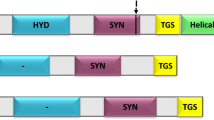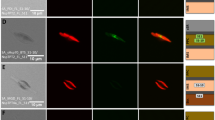Abstract
THE occurrence of fructose-1,6-diphosphate (FDP) aldolase in red algae (Rhodophyta) has been the subject of some controversy. Whereas Jacobi1 reported the absence of aldolase in four species of multicellular red algae, Fewson et al.2 were able to demonstrate activity of this enzyme in extracts of a multicellular species (Chondrus crispus) and a unicellular species (Porphyridium cruentum). The recent discovery of aldolase in blue–green algae (Cyanophyta)3,4 after earlier failures2,5 to detect it in this algal group indicates the need for similar re-examination and characterization of aldolase in the red algae. During comparative investigations on aldolase activity in marine phytoplankton species belonging to several classes of algae, we had occasion to re-examine the unicellular red alga Porphyridium cruentum Nägeli and were able to confirm activity. Furthermore, a developing interest in the biochemical evolution of aldolase6 prompted us to investigate certain characteristics of this enzyme activity, and we have obtained interesting results which may be of value to algal phylogeny.
This is a preview of subscription content, access via your institution
Access options
Subscribe to this journal
Receive 51 print issues and online access
$199.00 per year
only $3.90 per issue
Buy this article
- Purchase on Springer Link
- Instant access to full article PDF
Prices may be subject to local taxes which are calculated during checkout
Similar content being viewed by others
References
Jacobi, G., in Physiology and Biochemistry of Algae (edit. by Lewin, R. A.), 125 (Academic Press, New York, 1962).
Fewson, C. A., Al-Hafidh, M., and Gibbs, M., Plant Physiol., 37, 402 (1962).
Van Baalen, C., Nature, 206, 193 (1965).
Willard, J. M., Schulman, M., and Gibbs, M., Nature, 206, 195 (1965).
Richter, G., Biochim. Biophys. Acta, 48, 606 (1961).
Rutter, W. J., Fed. Proc., 23, 1248 (1964).
Antia, N. J., and Kalmakoff, J., Fisheries Res. Board Canada, Manuscript Rept. Ser. (Oceanog. Limnol.) No. 203 (1965).
Antia, N. J., and Watt, A., J. Fisheries Res. Board Canada, 22, 793 (1965).
Sibley, J. A., and Lehninger, A. L., J. Biol. Chem., 177, 859 (1949).
Cleland, W. W., Biochemistry, 3, 480 (1964).
DeMoss, R. D., and Bard, R. C., in Manual of Microbiological Methods (edit. by Comm. Bact. Technic, Soc. Amer. Bacteriologists), 181 (McGraw-Hill Book Co., Inc., New York, 1957).
Kowal, J., Cremona, T., and Horecker, B. L., J. Biol. Chem., 240, 2485 (1965).
Dougherty, E. C., and Allen, M. B., in Comparative Biochemistry of Photoreactive Systems (edit. by Allen, M. B.), 129 (Academic Press, New York, 1960).
Author information
Authors and Affiliations
Rights and permissions
About this article
Cite this article
ANTIA, N., CHORNEY, V. Nature of the Aldolase Activity in a Unicellular Red Alga. Nature 214, 1028–1029 (1967). https://doi.org/10.1038/2141028a0
Received:
Revised:
Published:
Issue Date:
DOI: https://doi.org/10.1038/2141028a0
Comments
By submitting a comment you agree to abide by our Terms and Community Guidelines. If you find something abusive or that does not comply with our terms or guidelines please flag it as inappropriate.



